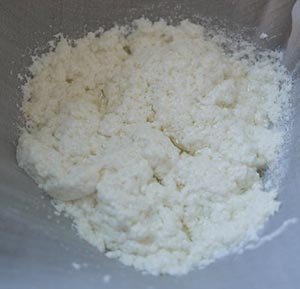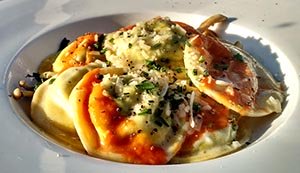Ricotta cheese
Ricotta, a fresh, soft, non-aged Italian cheese is made from "re-cooking" the whey leftover when full-fat cheeses are made. Further heating of this whey allows all the protein solids like alpha and beta lactalbumins, globulins, lactoferrin, etc, to coagulate and clump together as solid granules into delicious cheese mass.
It is naturally low in fat and salt and has a delicate, smooth flavor that works well in confectionaries.
 |
| Fresh whey ricotta cheese. Courtesy: Rebecca siegel |
Preparation of ricotta cheese:
Ricotta is a very simple cheese to make, but it demands a large volume of whey to prepare even a small portion of cheese. Acidified whey from the previous batch of cheese acts as its own coagulant, making it unnecessary to add vinegar or lemon juice to separate the curd. The end result is white creamy cheese mass, clumped together with fine, grainy textured milk solids.
Pieces of equipment required include a vat (or large bowl), cheesecloth, fine-mesh strainer, saucepan, thermometer, and ladle.
Traditionally, the whey intended to prepare ricotta cheese is poured into a clean, wide-mouthed bowl and heated till it reaches near-boiling point-175 degrees F. Once you see enough curdling done, turn off the stove. Allow curds to separate from the whey for about 15-30 minutes. Drain the curd using a cheesecloth until all the whey runs out. The result is a soft, moist cheese that has a very low fat content.
However, modern dairies often add whole/skim milk to the whey to increase cheese mass. In this case, food acid like lemon juice (citric acid) is added to curdle milk-whey blend while it continues to boil.
There are several types of ricotta:
Ricotta romano is made from sheep's rather than cow's milk and is available only from fall to early summer.
Ricotta salata is salted and dried.
Ricotta affumicata is smoked cheese from Sothern Italian Province Calabaria.
Smoked ricotta is a specialty produce of mountainous Northern Italy.
Ricotta infonata is produced in Sicily and is baked in the oven until it is lightly browned.
Top 8 Nutrition Facts and Health Benefits of Ricotta Cheese
Ricotta is the most famous, traditional Italian whey cheese. Non-salted and unripened ricotta is a low-calorie, nutritious, and protein and mineral-rich dairy product. 100 g fresh part skim-milk ricotta carries just 138 cal/3.5 oz.
Because ricotta is a whey-based cheese, whey protein (&bet;-lactoglobulin, α-lactalbumin, serum albumins, and immunoglobulins) accounts for about 40–45% of the solids in it. Hence, it is preferred cheese in milk-allergens who are allergic to major milk protein, casein.
Lactose content in fresh ricotta is relatively smaller than other soft cheese like mozzarella, cottage cheese, etc. Some traditional aged ricotta is composed of very small amounts of lactose (0.1 g/oz) which makes it easier to digest in lactose-intolerant people. Certain enzymes in ripening cheese convert lactose into more easily digestible lactic acid.
Ricotta is a gluten-free dairy product which makes it an important food item that is rich in protein, minerals, and vitamins for Celiac disease people.
It contains good amounts of calcium (272 mg/100 g or 27% of DA), magnesium, and phosphorous; and together with vitamin D, these minerals work in the growth and development of bone and teeth, especially in the children.
100 g of it provides 11.89 g of high-quality protein that is rich in all essential amino acids required for growth and development and robust health.
It is a healthy food product since most of the constituents in whey undergo biochemical changes into more easily digestible and health-benefiting products.
Ricotta contains all the vitamins available in the milk, both fat-soluble and B-complex groups of vitamins. It is particularly rich in riboflavin (0.185 mg or 16% of DA/100g) and vitamin A (384 IU/100g).
Ricotta also holds modest levels of zinc, selenium, iron, pyridoxine, vitamin E, and manganese. These minerals and vitamins take part in various metabolic functions in humans.
| Principle | Nutrient Value | Percent of RDA |
|---|---|---|
| Energy | 150 Kcal | 8% |
| Carbohydrates | 5.14g | 3.1% |
| Protein | 11.4g | 20% |
| Total Fat | 7.91g | 39.5% |
| Dietary Fiber | 0g | 0% |
| Vitamins | ||
| Folates | 13 μg | 3% |
| Niacin | 0.078 mg | <1% |
| Pyridoxine | 0.020 mg | 1.5% |
| Riboflavin | 0.185 mg | 15% |
| Thiamin | 0.021 mg | 2% |
| Vitamin-A | 384 IU | 13% |
| Vitamin-C | 0 mg | 0% |
| Vitamin-D | 6 IU | 1% |
| Vitamin-E | 0.07 mg | <% |
| Vitamin K | 0.7 μg | <% |
| Electrolytes | ||
| Sodium | 99 mg | 6.5% |
| Potassium | 125 mg | 2.7% |
| Minerals | ||
| Calcium | 272 mg | 27% |
| Copper | 0.034 mg | 4% |
| Iron | 0.44 mg | 5.5% |
| Magnesium | 15 mg | 4% |
| Phosphorus | 183 mg | 26% |
| Selenium | 16.7 μg | 30% |
| Zinc | 1.34 mg | 12% |
Buying
While buying, consider what type of ricotta you intend to buy depending upon the composition of fat and moisture contents.
Whole milk ricotta is manufactured from whole milk, and the finished product shall contain no more than 80% moisture and not less than 11% milk fat.
Part-skim ricotta is manufactured from milk with reduced milk fat content, and the finished product shall contain no more than 80% moisture and less than 11% but not less than 6% milk fat.
Ricotta (Ricotone) from whey is manufactured from whey, and the finished product shall contain no more than 82.5% moisture and less than 1% milk fat.
Fresh ricotta cheese is readily available year-round in groceries and supermarkets. Buy fresh ricotta in sealed containers/packs from refrigerated sections.
Good ricotta should be soft, creamy, moist, and grainy. It should be clear white or creamy with a sweet or slightly acidic flavor. Avoid any off-flavored, beyond-date products.
Storing
Being a fresh and soft cheese, ricotta is highly perishable and must be refrigerated in a well-sealed container. If you prepare it at home, make small batches frequently and store it well in the fridge for up to a week.
Food uses
Ricotta is a whey-based cheese and is best used as a dessert cheese and in pastries. It blends well with sugar, condiment spices, and berry fruits, or is used in a wide range of savory pasta dishes.
Here are some serving tips:
 |
| Ravioli - ricotta stffed. Courtesy: Pan Pacific |
Enjoy fresh ricotta mixed thoroughly with fruits and dried nuts as a dessert.
Prepare spinach and ricotta cheese stuffed - ravioli and serve with sage butter or creamy tomato sauce.
In Russia and other Eastern European nations, ricotta is substituted for tvoróg (творо́г) in delicious Syrniki (сырники), a traditional sweet pancake.
Torta di ricotta is an Italian dessert made with cream cheese and ricotta and flavoured with candied citrus peel and rum-soaked raisins (sultanas).
Safety profile
Ricotta is a soft, low-calorie cheese and is low in sodium and saturated fats, and therefore, recommended as a healthy dairy product in those who are on a low sodium and fat diet program.
Ricotta cheese contains small amounts of tyramine and can be eaten in small quantities by those on a tyramine-restricted diet. (Source: Queensland Government-low tyramine diet: MAOI's and diet.)
Since Ricotta is whey-cooked cheese, it is devoid of casein (which is the protein responsible for milk allergies) and less allergenic.
Also read ≻≻-
≺≺ American Cream cheese nutrition facts.
≺≺ Cheddar cheese nutrition facts.
≺≺ Back to Dairy products from Ricotta cheese nutrition facts.
≺≺ Back to Home page.
Further Resources:
USDA National Nutrient Database. (opens in new window).
- USDA Specifications for Ricotta Cheeses. (opens in new window).
Queensland Government- low tyramine diet..